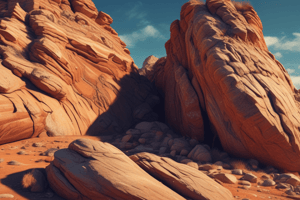Podcast
Questions and Answers
What is the primary process that transforms sediments into solid rock?
What is the primary process that transforms sediments into solid rock?
- Lithification (correct)
- Transport
- Weathering and Erosion
- Deposition
Which type of sedimentary rock is formed primarily from the precipitation of minerals?
Which type of sedimentary rock is formed primarily from the precipitation of minerals?
- Clastic
- Igneous
- Chemical (correct)
- Organic
What characteristic is commonly found in sedimentary rocks?
What characteristic is commonly found in sedimentary rocks?
- Generally softer and less durable (correct)
- Formed from high pressure
- Typically found in volcanic regions
- Highly resistant to weathering
Which condition is essential for fossil preservation?
Which condition is essential for fossil preservation?
What type of fossil provides indirect evidence of past life?
What type of fossil provides indirect evidence of past life?
How does the presence of fossils in sedimentary rocks primarily assist scientists?
How does the presence of fossils in sedimentary rocks primarily assist scientists?
Which type of fossil consists of actual remains of organisms?
Which type of fossil consists of actual remains of organisms?
What is a significant factor in the formation of both sedimentary rocks and fossils?
What is a significant factor in the formation of both sedimentary rocks and fossils?
Flashcards are hidden until you start studying
Study Notes
Sedimentary Rocks
-
Definition: Sedimentary rocks are formed by the accumulation and compaction of sediment, which can include minerals, organic material, and fragments of other rocks.
-
Formation Processes:
- Weathering and Erosion: Breakdown of existing rocks leads to the formation of sediments.
- Transport: Sediments are transported by wind, water, or ice.
- Deposition: Sediments settle in layers in various environments (riverbeds, ocean floors).
- Lithification: Compaction and cementation of sediments turn them into solid rock.
-
Types of Sedimentary Rocks:
- Clastic: Formed from fragments of other rocks (e.g., sandstone, shale).
- Chemical: Formed from the precipitation of minerals from solution (e.g., limestone, rock salt).
- Organic: Formed from the accumulation of plant and animal debris (e.g., coal).
-
Characteristics:
- Often layered (stratified).
- May contain fossils.
- Generally softer and less durable than igneous and metamorphic rocks.
Fossils
-
Definition: Fossils are the preserved remains, impressions, or traces of ancient organisms.
-
Types of Fossils:
- Body Fossils: Actual remains of organisms (bones, shells).
- Trace Fossils: Indirect evidence of life (footprints, burrows).
- Molds and Casts: Impressions left in sediment that can later be filled with minerals.
-
Formation of Fossils:
- Rapid Burial: Essential for preservation to protect remains from decay and destruction.
- Anoxic Conditions: Low oxygen environments slow decomposition.
- Mineral Replacement: Original materials may be replaced by minerals over time.
-
Importance of Fossils:
- Provide evidence of past life and ecosystems.
- Help in understanding evolution and extinction events.
- Used in dating rock layers (biostratigraphy).
-
Fossil Record:
- Incomplete but crucial for understanding the history of life on Earth.
- Shows changes in biodiversity over geological time.
Relationship Between Sedimentary Rocks and Fossils
- Sedimentary rocks often contain fossils due to the processes of sediment accumulation and lithification.
- Fossils found within sedimentary rocks provide insights into the environment of deposition.
- The study of fossils in sedimentary rocks aids in reconstructing past climates and geographical changes.
Sedimentary Rocks
- Formed by the accumulation and compaction of sediments, including minerals, organic materials, and rock fragments.
- Processes involved in formation include:
- Weathering and Erosion: Breaks down existing rocks into smaller sediments.
- Transport: Movement of sediments via wind, water, or ice.
- Deposition: Settling of sediments in layers in environments like riverbeds and ocean floors.
- Lithification: Transformation of sediments into solid rock through compaction and cementation.
- Types consist of:
- Clastic Rocks: Composed of fragments from other rocks, e.g., sandstone and shale.
- Chemical Rocks: Formed from mineral precipitation from solutions, e.g., limestone and rock salt.
- Organic Rocks: Result from the accumulation of plant and animal debris, e.g., coal.
- Characteristics include:
- Frequently layered (stratified) structure.
- May contain fossils, providing insights into ancient life forms.
- Generally softer and less durable than igneous and metamorphic rocks.
Fossils
- Represent preserved remains, impressions, or traces of ancient organisms.
- Types include:
- Body Fossils: Actual remains like bones and shells.
- Trace Fossils: Indirect evidence of life such as footprints and burrows.
- Molds and Casts: Impressions in sediment that can be filled with minerals to create replicas.
- Formation requires:
- Rapid Burial: Essential to prevent decay and protect remains.
- Anoxic Conditions: Low oxygen environments that slow decomposition.
- Mineral Replacement: Original materials can be replaced by minerals over time.
- Importance of fossils:
- Provide evidence of past life and ecosystems.
- Aid in the understanding of evolution and extinction events.
- Useful in dating rock layers through biostratigraphy.
- The fossil record is incomplete but vital for tracing Earth's biological history and changes in biodiversity over geological time.
Relationship Between Sedimentary Rocks and Fossils
- Sedimentary rocks often contain fossils as a result of sediment accumulation and lithification processes.
- Fossils within sedimentary rocks offer insights into past depositional environments.
- Studying fossils in these rocks assists in reconstructing historical climates and geographical changes.
Studying That Suits You
Use AI to generate personalized quizzes and flashcards to suit your learning preferences.




